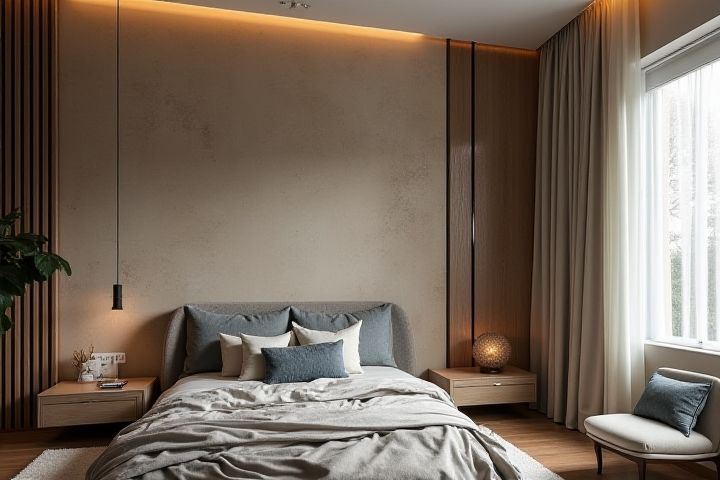
To soundproof your house from traffic noise, consider installing acoustic windows, which have multiple layers of glass that reduce sound transmission. Weatherstripping doors and windows can also significantly minimize unwanted noise, as gaps in these areas often allow sound to seep through. Heavy curtains or soundproof drapes can dampen outside noise while enhancing your home's aesthetics. Adding insulation to walls and ceilings helps absorb sound, while thick carpets or area rugs can reduce echoes and vibrations within your space. Finally, creating outdoor barriers such as a solid fence or planting dense vegetation can further diminish noise from nearby roads.
How To Soundproof A House From Traffic
Use thick, insulated windows.
Thick, insulated windows are essential for effectively soundproofing your home from traffic noise. Double or triple-pane glass can reduce outside noise by up to 60% compared to standard single-pane windows. These windows feature insulated frames that minimize vibration and provide better thermal performance, ensuring your living space remains quiet and comfortable. Investing in high-quality, soundproof windows can significantly enhance your home's tranquility, allowing you to enjoy a peaceful environment away from bustling streets.
Install solid core doors.
Installing solid core doors significantly enhances soundproofing in your home by reducing noise from traffic and other external sources. These doors are typically constructed with a dense, heavy framework, which helps absorb sound vibrations more effectively than hollow core doors. For optimal results, ensure that the doors fit snugly in the frame, minimizing gaps where sound can enter. Consider adding weatherstripping around the edges to further block noise and improve energy efficiency simultaneously.
Add weather stripping.
Weather stripping plays a crucial role in soundproofing your house from traffic noise. By applying high-quality weather stripping along doors and windows, you can significantly reduce sound infiltration, blocking out bothersome external noises. A removable or self-adhesive option can provide an easy installation process, ensuring a tight seal that can lower noise levels by up to 50%. This simple yet effective addition not only enhances your home's acoustics but also improves energy efficiency, saving you money on heating and cooling.
Seal gaps and cracks.
To effectively soundproof your house from traffic noise, sealing gaps and cracks is crucial. Use acoustic caulk, which remains flexible and can fill gaps in walls, windows, and doors, ensuring no sound leakage. It's essential to check for spaces around electrical outlets, window frames, and baseboards; even small openings can significantly reduce sound insulation. For best results, combine caulking with weatherstripping on doors and windows, enhancing both the soundproofing and energy efficiency of your home.
Hang heavy curtains.
Hang heavy curtains made from dense, sound-absorbing materials to effectively reduce traffic noise entering your home. Opt for floor-to-ceiling lengths to maximize coverage and minimize sound leakage around window frames. Ensure you choose curtains that fit snugly within the window space to block any gaps where sound can seep through. You'll find that these heavy drapes not only enhance your room's decor but also create a quieter, more serene living environment.
Use soundproof drywall.
Using soundproof drywall is an effective method to reduce traffic noise in your home. This specialized drywall contains a layer of viscoelastic polymer, which significantly absorbs sound vibrations, resulting in a 30 to 40 percent reduction in noise transmission compared to standard drywall. To maximize effectiveness, pair soundproof drywall with acoustic caulk in the seams, ensuring a tighter seal that further blocks sound leaks. For optimal results, consider applying this solution to walls adjacent to highways or busy streets, where noise levels can exceed 70 decibels.
Add a layer of mass loaded vinyl.
Adding a layer of mass loaded vinyl (MLV) to your walls can significantly reduce traffic noise penetrating your home. MLV, typically weighing around 1 pound per square foot, is an effective sound barrier due to its density and flexibility, making it ideal for soundproofing applications. To install, attach the MLV directly to your existing walls or between wall studs, ensuring there are no gaps for sound to escape through. By incorporating MLV, you can lower noise levels by up to 20 decibels, creating a quieter, more serene living environment away from the hustle of the road.
Install acoustic panels.
Installing acoustic panels can significantly reduce the noise from traffic, enhancing your home's tranquility. These panels, made from sound-absorbing materials, can decrease sound reflection, improving overall acoustics in a room. For optimal effectiveness, place panels strategically on walls that face the street; a typical recommendation is to have at least 20% of the wall surface covered. Depending on the size of your room, you may need between 6 to 12 panels to achieve the desired sound reduction.
Lay down thick carpets or rugs.
To effectively reduce traffic noise in your home, consider laying down thick carpets or rugs, which can absorb sound waves and diminish their impact on your living space. Choose carpets with a high density of fibers, as they provide better sound insulation; wool or synthetic options can be particularly effective. Strategically placing rugs in high-traffic areas, such as hallways and living rooms, can further enhance soundproofing efforts. Make sure to cover as much of the floor area as possible, as larger surfaces will provide more significant noise reduction.
Utilize furniture to absorb sound.
Utilizing furniture to absorb sound is an effective strategy for soundproofing your home against traffic noise. Incorporating large, soft furnishings such as sofas, rugs, and curtains can significantly reduce sound transmission; for instance, plush area rugs can decrease noise by up to 30%. Positioning bookshelves filled with books against exterior walls enhances sound absorption, while upholstered furniture absorbs and diffuses sound waves. You can optimize your space by strategically arranging furniture to create barriers, creating a quieter and more comfortable living environment.
